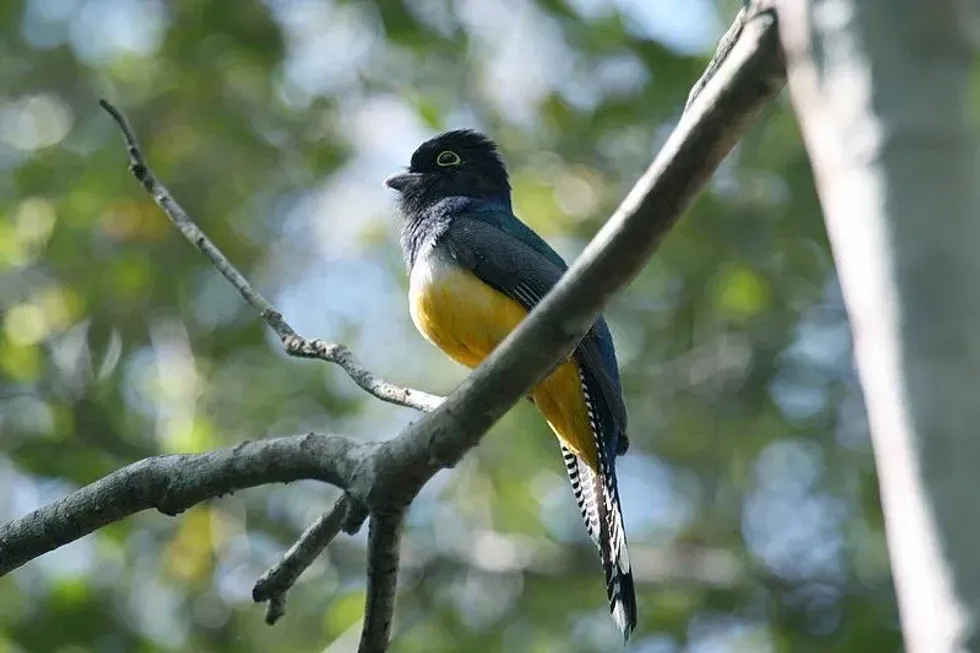Trogons are a type of bird that is distributed throughout the tropical and subtropical regions of the world. The gartered trogon (Trogon caligatus) is one of the many species of new world trogon that occurs from south of Central America to northwestern parts of South America.
Previously, the gartered trogon was regarded as a subspecies of the violaceous trogon (Trogon violaceus) and was referred to as northern violaceous trogon. However, due to genetic differences, they have formed a different species with their own set of subspecies.
The fragmented bird population has been observed in Honduras, Belize, Northwest Costa Rica, and Yutacan. Most of the birds populate the humid lowlands of their range.
The gartered trogon is fairly common in Mexico, Panama, and Caribbean pacific subtropics. Numerous northern violaceous trogons are found in tropical El Salvador, the lowlands of Guatemala, and Venezuela.
The bird exhibits a unique behavior of inhabiting ant or termite nests, thereby co-existing with these insects in their nest. This behavior of the gartered trogon and violaceous trogon (Trogon violaceus) is known as anting.
The gartered trogon is a monogamous new world bird that mates for life. The pairs do not build separate nests for breeding and laying, they depend on the arboreal vespiary of wasps or ant and termite mounts to raise the chicks. To know more facts about the birds, keep on reading these amazing facts.
For similar content, check out narina trogon facts and elegant trogon facts too.
Gartered Trogon Interesting Facts
What type of animal is a gartered trogon?
A gartered trogon (Trogon caligatus) is a type of new world bird.
What class of animal does a gartered trogon belong to?
The gartered trogon (Trogon caligatus) of order Trogoniformes and family Trogonidae belong to the class Aves, the common class for all birds.
How many gartered trogons are there in the world?
The population status of the gartered trogon (Trogon caligatus) has not been determined. There is very little information regarding their global population trend.
Where does a gartered trogon live?
Trogon caligatus (gartered trogon) is divided into three subspecies based on differences in distribution. Trogon caligatus sallei is the most widespread gartered trogon found in Mexico.
They are found throughout the Caribbean slope of eastern and south Mexico and the Pacific slope of southern Mexico. This race is also present in the forests of northern Honduras, El Salvador, Guatemala, and Belize.
Trogon caligatus caligatus are found across western parts of Venezuela, north Colombia, and northeast Panama in the Caribbean slope. Another new world trogon race, Trogon caligatus concinus is found throughout the rest of Panama and also in western Colombia, northwest Peru, and Costa Rica.
What is a gartered trogon's habitat?
This species of trogon (Trogon caligatus) can adapt to several types of habitats. In the northern part of their range, the birds inhabit the dense evergreen forests and the rainforests of the tropics.
They are also found in woodlands, forest edges and clearings, mangrove areas, and among plantations in east-central Mexico.
Gartered trogons are associated with dark and shady secondary growth in Colombia and Panama rather than the interiors of forests. In Costa Rica, the new world bird occurs in the drier canopy regions but trogon can also occupy the humid forest edges and semi-open clearings with tall and scattered trees.
Who do gartered trogons live with?
The trogon of the Trogonidae family generally does not fall under the category of gregarious birds. The specific social behavior of the violaceous trogon or gartered trogon (Trogon caligatus) is still unobserved.
How long does a gartered trogon live?
The lifespan of the gartered trogon (Trogon caligatus) species has not been determined.
How do they reproduce?
There is limited information regarding the behavior of the breeding male and female. Breeding reaches a peak between May to June but generally varies according to the climate conditions of different regions.
They can also lay eggs in excavated holes of old trees. The gartered trogon female lays two to three white eggs in a single clutch and the chicks emerge after an incubation period of 17 days.
What is their conservation status?
The conservation status of the gartered trogon (Trogon caligatus) has not been evaluated, these new world birds are Not Listed in the IUCN Red List. However, because of the large gartered trogon range and stable population, the trogons are not threatened globally.
Suspected habitat destruction in some parts of their range has probably affected their population but there is no record of any major impact yet.
Gartered Trogon Fun Facts
What do gartered trogons look like?
The gartered trogon (Trogon caligatus) is a new world bird of the Trogonidae family that exhibits a large variety of bright colors. The plumage of male trogons differs widely from that of females. The male bird has a black throat and violet-blue head and breast.
The rest of the under part is bright yellow in color. The yellow underpart is divided from the rump by a white band. The dorsal part of the male birds is green.
The tail feathers and the under tail feathers of the birds are dark blue-black with white wavy lines. The bird has a dark grey head and a dull yellow abdomen. Females produce white eggs after mating.
How cute are they?
The gartered trogons (Trogon caligatus) are strikingly colored birds. They look beautiful because of their colors.
How do they communicate?
The gartered trogon (Trogon caligatus) communicates by vocalizations. They produce a series of low kyu-kyu-kyu calls.
How big is a gartered trogon?
The gartered trogon (Trogon caligatus) can reach a length of 9 in (23 cm). They are 2 in (5 cm) smaller than the black headed trogon.
How fast can a gartered trogon move?
The gartered trogon (Trogon caligatus) is a fast flyer, but unfortunately its speed is not determined.
How much does a gartered trogon weigh?
The weight of a gartered trogon (Trogon caligatus) ranges between 1.3-2 oz (38-57 g).
What are the male and female names of the species?
The male and the female gartered trogon (Trogon caligatus) are referred to as cocks and hens.
What would you call a baby gartered trogon?
A baby gartered trogon (Trogon caligatus) is called a chick.
What do they eat?
The species of gartered trogon (Trogon caligatus) eat small fruits and invertebrates like caterpillars, katydids, termites, and spiders.
Are they dangerous?
No, they are not dangerous.
Would they make a good pet?
The gartered trogon is a wild species. They prefer staying in their natural habitat.
Did you know...
The species of gartered trogon or violaceous trogon (Trogon violaceus) live inside ant nests because it is believed that the formic acid that the ants release on their body protects their feathers from feather parasites.
How did the gartered trogon get its name?
The species of gartered trogon (Trogon caligatus) were formerly regarded as violaceous trogon (Trogon violaceus). However, due to genetic differences, the species violaceous trogon (Trogon violaceus) were divided into three subspecies, one of them being the gartered trogon.
How high can gartered trogons fly?
The gartered trogon (Trogon caligatus) can fly at low to moderate elevations. Although The elevation limit of the gartered trogon is assumed to be 5900-6000 ft (1800-1850 m) currently, they have been recorded at the highest elevation of 4593 ft (1400 m).
Here at Kidadl, we have carefully created lots of interesting family-friendly animal facts for everyone to discover! For more relatable content, check out these fig parrot facts and dusky parrot facts for kids.
You can even occupy yourself at home by coloring in one of our free printable exotic bird coloring pages.










